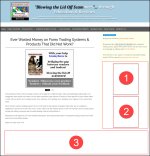- Home
- Girvan Lambert
- The Use of the Fibonacci Calculator for the Trading of the Touch and the Call/Put Options
The Use of the Fibonacci Calculator for the Trading of the Touch and the Call/Put Options
by Girvan Lambert
(Canada)

Fibonacci
I couldn't help noticing that this site has made a handy Fibonacci calculator available to its visitors for free, a tool which can indeed be an extremely useful one, provided one knows how to put it to work. Below I'm going to present a system/trading strategy will makes use of the Fibonacci calculator, and which is aimed at helping with the trading of the Touch component of the Touch/No Touch contract (it is indeed not suitable to be used for the trading of the No Touch component as you'll see below). The Fibonacci retracement tool is apparently among the least understood indicators in trading, which is obviously a shame, because it is neither particularly difficult to comprehend, nor too intricate/cumbersome to use. Essentially, if you're a trader and you're not using this tool to its full potential, you're obviously missing out on potential profits.
The Fibonacci retracement tool is meant to take advantage of retracements which are obvious parts of any market. Trends come and go, and interspersed among them are retracement periods. Regardless of how strong a trend is, it is in the nature of the market to retrace every now and then. These periods represent the profit-taking activity of those who got into the asset early and feel they're entitled to cash in (these entities can be individual traders or institutional players). What we're aiming to accomplish through this strategy is to exploit these temporary retracements through the trading of the Touch option.
The first step is to establish the time-frame that we'll use for analysis. The importance of this step cannot be overstated, not only in this instance, but every time we attempt to draw conclusions for trading through technical analysis. What we'll use in this case is the daily chart and I think the choice is obvious: what we need here is to be able to spot actual trends, and the intra-day noise prevalent in hourly or 15-minute charts isn't helpful at all. To make a long story short in this respect: an asset-price movement which may seem like a trend-reversal on an hourly chart, may simply be part of the actual trend on the daily one. Through the use of the daily chart, we'll look right past this noise and spot actual retracements induced by profit-taking.
As always, the crux of the system we'll use is extremely simple: when a retracement occurs, through the use of the Fibonacci retracement tool, we'll establish possible target points that the retracement may end up touching. One of these targets will serve as our strike price for the Touch option. The Fibonacci retracement tool will set five such possible retracement points for us: at the 23.6%, 38.2%, 50%, 61.8% and 100% retracement levels. What we'll need to do for better visual illustration is to apply the retracement tool straight to the chart, letting it draw up its retracement levels automatically. Alternatively, we can also accomplish this exercise manually, by entering the required values (we will take a look at exactly what these values are immediately) into the tool featured here, which will then give us the retracement levels, enabling us to trace them on the chart manually.
Let's consider that our asset-price is in an uptrend, working its way towards a downward retracement. In this case, we'll identify the swing low (the lowest asset -price value on the chart) and the swing high (the highest price point) and trace a line from the swing low to the swing high with the tool. Once that's done, the 5 retracement levels will show up on our chart, color-coded in yellow (blue on the illustration).
If we're looking at a downtrend, we'll use the tool to trace a line from the swing high to the swing low. Once this has been accomplished, the stage has essentially been set for the placing of the actual Touch trade. This can be done in two different ways.
The first method would be the straightforward one, which goes like this: whenever there's a retracement, the asset-price will usually breach the 23.6% and 38.2% levels. These two levels represent extremely attractive targets for our Touch strike-price. Once the 23.6% level has been breached and the asset price continues to retrace, the trade should immediately be placed using the 38.2% level as the strike-price, with an expiry of 10 days. The expiry has to be this generous to increase the chances of success: even if the Touch condition is fulfilled early, with several days left on the expiry, the trade is still a success.
Another way to do it is to identify the potential end of the retracement, for which purpose we'll bring in the overbought/oversold stochastic oscillator. Once this critical level has been identified and the retracement does indeed seem to come to an end, the Touch trade should be placed on the previous Fibonacci retracement level, towards which the price will now move.
The No Touch component of the Touch/No Touch contract cannot be traded with this setup, but that's obviously not a disadvantage in any way.
The trading of the Put/Call options is done in a way similar to the second method of trading the Touch contract described above. To trade the Put/Call, we'll need to identify the end of the retracement, which will occur at one of the 5 retracement levels, and for which we'll use the Stochastic Oscillator as specified above.
In the case of an uptrend retracement (when we're looking for the uptrend to resume) we're obviously looking for an oversold situation, where the lines of the stochastic oscillator cross at <30. Where the asset price touched one of the Fibonacci levels and where the above said condition is fulfilled at the same time, that's where the end of the retracement will occur. The Call trade should be placed at this point, with an expiry of at least 7 days (remember that we used the daily chart for analysis).
The Put trade works in a similar fashion, but it's obviously for the reverse situation: we have a downtrend, with an upward retracement, the end of which we'll identify with the combined use of the Fibonacci levels and the stochastic oscillator (overbought situation = lines cross at >70). The Put trade will be entered at that point (on the very next candle if possible), with a similarly generous expiry.
Now then, everything discussed above is very straightforward and logical. With the illustration, the use of the Fibonacci levels and of everything else involved seems like a piece of cake. Mind you though that this is not the case in a real, live situation. To truly make this system effective, traders should practice it on demo accounts first. It is indeed simple, and it can indeed be extremely efficient, but one needs to master it under fire so to speak.
Auto binary option traders work based on similar systems/principles, but they usually do a better job at spotting patterns, drawing conclusions and purchasing trades than humans.
Return to Girvan Lambert's Articles.





